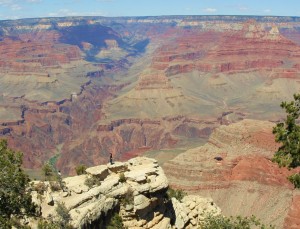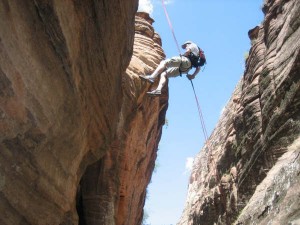 The Grand Canyon spread its magnificent sandstone expanse upward and away, colors swirling in its impossibly steep walls, contrasting the distant pale blue sky, an immense reverse river wending its way for unseen miles.
The Grand Canyon spread its magnificent sandstone expanse upward and away, colors swirling in its impossibly steep walls, contrasting the distant pale blue sky, an immense reverse river wending its way for unseen miles.
I sat there, exhausted, beat up, and in exaltation, feeling about as significant as the sand below me, waiting for its turn to be swept away by the rising spring current, but triumphant in having made the journey.
This was not what I had bargained for—not the torn up and worn condition of my body, and not the sublime accomplishment of having done something difficult yet worth doing.
I had not planned this trip, and the proposed mile and a half hike “down the lava flow” in the Grand Canyon had been billed to me as possibly tricky.
My brothers hadn’t read me the part, if it had been in their guides, about brutal, perilous, confusing, and torturously steep.
Only a mile and a half?
I have hiked rugged terrain for fifteen or more miles in a day and not been as tired and tried as I felt at the end of this one.
I had, just the week previous, had quite a different experience in quite different canyons.
Zion National Park is one of the most scenic and beautiful of canyons anywhere—an oasis of fantastic sandstone forms and elegant hidden beauty. Zion is not as staggeringly impressive as the Grand, but no less impressive and wondrous all the same.
There, the goal was to descend canyons of an entirely different character. Zion is a well-traveled and visited park, and there are paved trails that will get you to some great scenery and interesting hiking.
Hidden through the park, though, are canyons that no paved path could get you down—nature’s secret passages through its castle’s walls.
Canyoneering involves making your way down canyons that are impassable without climbing gear, rappelling down a series of 30 to 300 foot drops into the curved weather- and water-made carvings, tens of thousands of years in the making.
Awaiting you in these sequenced caverns are, usually, pools of often freezing water and an amazing sense of mystery and of visiting places only visited by the relative few.
The one comment that is heard every time we go canyoneering is, “Why don’t more people do this?”
Leadership Education
It strikes me that entering a canyon is a great metaphor for an education—I mean a real education—a leadership education in which one becomes intimate with the classics, a full participant in the great debate, one in which he learns how to think for himself.
A great education should be both deep and broad; broad like the expanse of the Grand Canyon, a vista from which one can draw inspiration and a big picture; deep like the canyons in Zion, where you need to have technical gear and know-how, and good friends and guides to help you uncover uncommon knowledge and wisdom.
Obstacles in the Path
This comparison also reveals the obstacles to a great education.
The first obstacle is that, like my trip into the Grand, an education is simply hard.
A foray into the Federalist Papers will quickly show you what I mean. The language alone of the erudite Madison and Hamilton is terrain that most will find a bit too rigorous at first passing.
Launching into Plato can be a steep decent. Like preconceived notions, rocks that you thought were solid don’t always hold up when you test them with your full weight.
A slog through the uncertain sand of the writing process can leave you exhausted if you do it right.
That education is hard doesn’t mean that it is not enjoyable. Nothing is more enjoyable than doing that which is both difficult and worthwhile–to fully engage with nature, or with the world of ideas, and to feel oneself grow and expand from the experience.
 Like the back canyons of Zion, the way to a great education is the road less traveled.
Like the back canyons of Zion, the way to a great education is the road less traveled.
People lack education simply because they have accepted the way that education is presented to them in the mainstream, and it never occurs to them that more is possible, or possibly needed.
The obstacle for such individuals is that the bar has simply been set too low.
Do we have a large group of people in America who are able to see through propaganda, or who understand the cultural currents, who can move organizations, communities, and families toward greater good and effectiveness?
A deep and broad education is obtainable for each of us, but because it is uncommon and off the beaten track, you need guides, mentors, and friends to help you find your path, and to both challenge you and guide you safely along as you navigate the difficulties and overcome the obstacles.
One final comparison needs to be made, and that is that on both of these adventures, all of the beauty and struggle, all of the trekking and exploring, just are not that meaningful without the shared experience of fellow travelers.
A book, however excellent, is worth twice the value when shared with another, with a group, or with a society of readers.
Nature too is a common experience, like a common language that we share, and which grows in significance and beauty when shared with others.
Traveling and experiencing these canyons with good friends in Zion and family in The Grand, we traveled in each case to the accompaniment of good conversation, brotherhood, and the shared appreciation for the natural splendors, and rigors, that we experienced.
Education is about discovering the good, finding truth and beauty, and about the human experience—making the most of our talents and fully engaging with our mortal experience.
To steal from my favorite Robert Frost poem, one can do worse than be a climber of canyons.
So on to canyons deep and wide that we have yet to explore.






Speak Your Mind
You must be logged in to post a comment.